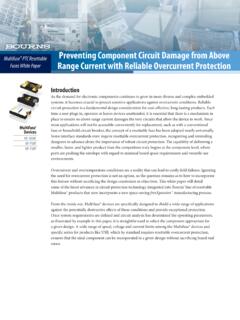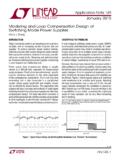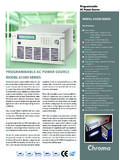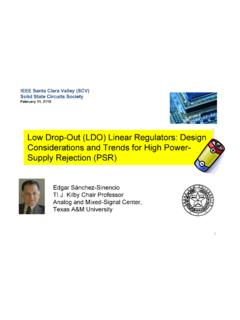Transcription of Designing a Low Power Flyback Power Supply - …
1 APPLICATION NOTED esigning a Low Power Flyback Power Supply8/14 e/K1442 Bourns is a well-known supplier of standard off-the-shelf high Power inductors for Power supplies in consumer, medical and automotive applications. Bourns also has a strong reputation in resistive products for various functions. This application note explains the key steps in Designing two of the most important components in a Flyback converter - the transformer and the snubber resistor. Flyback converters are very popular topologies in a variety of segments, both in DC/DC and offline (50 Hz, 120 V or 230 V input) circuits. The chief reasons for their popularity are as follows: Isolation from high voltages Fewer components than other topologies CostHowever, this application note will demonstrate that Flyback converters can generate losses, especially if the transformer is not designed properly. It is not common to see flybacks operating at higher than 100 W of Power due to the losses in the transformer.
2 Other topologies can achieve higher efficiencies. Power supplies of up to 100 W cover many consumer and automotive applications such as appliance control boards, LED drivers and many a Low Power Flyback Power SupplyVfPrimary switch VoltageVXSecondaryWinding VoltageSecondaryCurrentPrimaryCurrentSwi tch ONVOUTP rimaryCurrentSwitch OFFVOUTP rimaryCurrentO VoltsO VoltsVoutVin + Vout*n0 Amps0 AmpsVin28/14 e/K1442 The basic operation of the Power stage of a Flyback Power Supply is shown in figure 1. Turning on the switch causes the current in the primary winding and the switch to increase. A diode in the secondary side is used to prevent any current from flowing to the load during the time that the primary is conducting. The Flyback transformer will have a gap in its core to store the energy from the primary side during the on time which is then discharged into the secondary side as soon as the primary switch is turned off and the diode becomes forward biased.
3 As the switch turns off, the voltage across it flies back to a voltage that is fixed by an RCD snubber network. In reality, the Flyback transformer is an isolated inductor as it stores energy every cycle. A true transformer does not store any energy as it transfers energy immediately from a source to its load. The waveforms shown are taken from a Flyback operating in continuous mode , when the current in the inductor never reaches OF THE Flyback TOPOLOGYF igure 1. Waveforms and Basic Operation of a Flyback ConverterDesigning a Low Power Flyback Power Supply38/14 e/K1442 Turns ScenarioPrimary W1 Secondary W21121224234844968512010624012 Minimum Rectified Input Voltage150 VRMSO utput Voltage12 VDCE fficiency70 %Output WSwitching Frequency60 kHzMaximum Duty StandardIEC 61558-1, 61558-2 Pollution Degree2 The challenge is to design the Power stage of a Flyback converter for an appliance application with the following specifications: The most important element in the Power Supply is the transformer.
4 If this is designed incorrectly then the Power Supply may be inefficient and could cause increases to the EMI spectrum which may overheat, causing design the transformer, we first have to calculate the turns ratio. This is done by looking at the circuit and calculating the secondary winding voltage. The output is 12 VDC but there are losses caused by the diode and the Printed Circuit Board (PCB) itself. The secondary winding voltage is, therefore: V (12 V + V (Diode) + V (PCB conduction) = V). We want to help ensure that the turns ratio will provide a minimum of V which occurs at the lowest rectified voltage. If the rectified voltage is higher than V, then the control loop can adjust the duty cycle accordingly. Therefore, we have an overall ratio of 12 (12 x = 150 V). We could have any of the following turns as shown in the matrix below. However, the actual number of turns requires consideration and will be demonstrated later. Having an integer number of turns makes calculations and manufacturing efficiency is set at 70 % making the input Power W.
5 The average input current at 150 V is A. The input current will have a sawtooth shape where the peak-to-mean ratio is 4. Hence, the peak input current is A. The inductance, therefore, required in the primary side is mH (taken from e = ). The gap required is . We need to select a suitable core before we can calculate the gap length. Again, for practical reasons we will round the inductance value up to 12 OF THE PROBLEMDESIGN PROCEDURET able Converter Appliance Application SpecificationsDuty Cycle Turns MatrixLdidtlg =N oALDesigning a Low Power Flyback Power SupplySecondaryWinding W2 PrimaryWinding W16 mm Margin48/14 e/K1442 DescriptionValueVariableArea of Core mm 69 ASaturation Flux Density of TBsPeak AIpkPrimary Inductance12 mHLpriMinimum Number of Turns48 NThe construction of the Flyback transformer depends on the following components: Core shape and bobbin Core materialAs the Flyback transformer is really two coupled inductors, we have to be careful not to saturate the device.
6 Therefore, the minimum number of turns in the primary is important. The product of saturation flux density, turns and core area must be greater than the product of the primary inductance and the peak current to avoid saturation ( > (Equation 1)) .If we select an EFD30 core with a 3F3 material, we can plug the following values into equation 1 giving us a minimum number of turns of this is the minimum number of turns, we can select any number above that. Our turns ratio is 12 so a multiple of 12 will provide us with an integer number of secondary turns. Let us try a primary of 60 gap is, therefore:The wire thickness of the primary and secondary depends on the space available. According to EN 61558, the creepage and clearance for a Flyback transformer in an AC mains application in a pollution degree 2 environment is 6 mm. This is the minimum distance allowed between the nearest live conductor, or in this case, the primary and secondary. To implement 6 mm creepage, blocking tape, otherwise known as margin tape, is stuck to the side of the bobbin.
7 Putting 3 mm on each side will ensure a creepage and clearance of 6 mm between the two EFD30 bobbin has a window of mm in total. If we take away our 6 mm of margin, this leaves us with a total window of mm or inches. This means we need a wire that can fit 60 turns in inches or 108 turns per OF THE TRANSFORMERF igure of a TransformerEquation 1 Matrixlg === mmN A(60) A .4 .10-7 . a Low Power Flyback Power Supply58/14 e/K1442 Looking at winding tables, it is clear that 32 gauge enamel wire will fit 113 turns per inch. 32 gauge enamel wire has a resistivity of ohms per cm. The mean length per turn of an EFD30 bobbin is mm, according to the manufacturer s data sheet. Therefore, the total DC resistance of the primary is 60 turns ohms = ohmsThe rms current in the primary is given by the equation = A. The DC winding loss in the primary therefore is 13 mW, which is quite total flux generated by a Flyback has two components called Bdc and Bac.
8 Bdc is generated by the Ampere Turns (Amperes Law) and is calculated as follows: Bdc = = 4 .10-7 . = 70 mTBac is generated by the voltage across the winding when the switch is on (Faraday s Law).Bac = = 600 mTThe peak flux density is 670 mT, which is above the saturation limit of 3F3 material. The curves for 3F3 material also show a core loss of 3000 kW/m3 or 18 W. The most obvious change to reduce the core loss is to increase the number of turns on the primary side to 144 and the secondary turns to 12. This will give a flux density of 250 mT with a density of 120 kW/m^3 or a core loss of therefore need to reduce the size of the wire we are using. We now require 259 turns per inch. 40 gauge wire will suit this application giving a resistance of 30 ohms. Despite the high resistance of the primary, the rms current is low enough to make the winding losses key factor in the Flyback transformer is leakage inductance. An ideal transformer has perfect coupling between the primary and secondary windings with no losses.
9 However, in reality, the coupling is less than 100 percent, leaving what is in effect an inductance in series with the primary coil. This is known as leakage inductance which is minimized by adhering to the following methods: Fill each layer with a winding. In our design, the wire width is optimized to fill the layer. If there were empty spaces, the winding could be made spiral to take up more space. Interleaved windings - this can be done by splitting the primary into two layers and fitting the secondary in the center. However, this increases the proximity measures reduce the leakage inductance but will not eliminate it. Therefore, at switch turn off there will be a high voltage generated across the leakage inductance in accordance with Lenz s law. The combination of the leakage inductance and any parasitic capacitance will cause a ringing waveform to appear across the drain of the switch and this can be destructive if not dampened. The ringing frequency created can also affect the EMI spectrum.
10 This is where the snubber network can be used to attenuate the energy generated by this L, C OF THE TRANSFORMER (Continued)lrms =Ipeak . a Low Power Flyback Power SupplyVfPrimary switch FDD2R1C268/14 e/K1442 The interwinding capacitance is also responsible for the destructive ringing which can exceed the rated drain to source voltage (Vds) of the switch and the output diode reverse breakdown voltage. The capacitance is given by the equation C = where o and are the absolute and relative electrical permittivity constants. A is the area of the exposed winding and d is the distance between windings. Increasing the distance between the windings using insulation tape is one way to reduce capacitance. However, the increased distance reduces the coupling factor which in turn increases the leakage inductance. The largest reduction in capacitance is done by putting a Faraday shield between the windings. This is normally a single conductive foil with one connection to ground.















